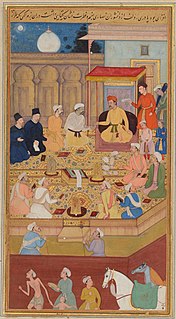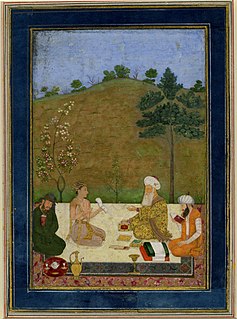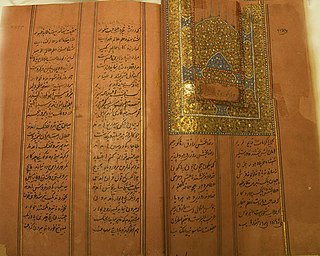 W
WThe Dabestān-e Mazāheb "school of religions" is a Persian language work that examines and compares South Asian religions and sects of the mid-17th century. The work, whose authorship is uncertain, was probably composed in about 1655 CE. The text's title is also transliterated as Dabistān-i Mazāhib, Dabistan-e Madahib, or Dabestan-e Madaheb.
 W
WThe Ḥabīb al-siyar fī akhbār afrād al-bashar is a universal history by the Persian historian Khvandamir.
 W
WKelidar is a novel written by Mahmoud Dowlatabadi. The novel consists of ten books in five volumes. The book was written in 15 years, and includes Iranian Folklore themes. Kelidar has been translated into different languages. Kelidar refers to the name of a mountain and a village in Khorasan, where the events of the novel take place.
 W
WKamal Khujandi, also Kamal Khojandi, Kamaleddin Khojandi, or Kamal-E Khojandi, was a Persian Sufi and Persian ghazal poet of the 14th century.
 W
WPersian literature comprises oral compositions and written texts in the Persian language and is one of the world's oldest literatures. It spans over two-and-a-half millennia. Its sources have been within Greater Iran including present-day Iran, Iraq, Afghanistan, the Caucasus, and Turkey, regions of Central Asia and South Asia where the Persian language has historically been either the native or official language. For example, Rumi, one of the best-loved Persian poets, born in Balkh or Wakhsh, wrote in Persian and lived in Konya, at that time the capital of the Seljuks in Anatolia. The Ghaznavids conquered large territories in Central and South Asia and adopted Persian as their court language. There is thus Persian literature from Iran, Mesopotamia, Azerbaijan, the wider Caucasus, Turkey, Pakistan, Bangladesh, India, Tajikistan and other parts of Central Asia. Not all Persian literature is written in Persian, as some consider works written by ethnic Persians or Iranians in other languages, such as Greek and Arabic, to be included. At the same time, not all literature written in Persian is written by ethnic Persians or Iranians, as Turkic, Caucasian, and Indic poets and writers have also used the Persian language in the environment of Persianate cultures.
 W
WRawżat aṣ-ṣafāʾ fī sīrat al-anbiyāʾ w-al-mulūk w-al-khulafāʾ or Rawdatu 's-safa is a Persian-language history of the origins of Islam, early Islamic civilisation, and Persian history by Mīr-Khvānd. The text was originally completed in seven volumes in 1497 AD; the eighth volume is a geographical index. The work is very scholarly, Mīr-Khvānd used nineteen major Arabic histories and twenty-two major Persian ones as well as others which he occasionally quotes. His work was the basis for many subsequent histories including the works of Hajjī Khalfah.
 W
WThe Sirr-i-Akbar is a version of the Upanishads authored by the Mughal-Shahzada, Dara Shukoh, translated from Sanskrit into Persian, c. 1657. After years of Sufi learning, Dara Shukoh sought to uncover a common mystical language between Islam and Hinduism, boldly stating that the Kitab al-Maknun, or "Hidden Book", mentioned in the Qur'an is none other than the Upanishads.
 W
WTutinama, literal meaning "Tales of a Parrot", is a 14th-century series of 52 stories in Persian. The work remains well-known largely because of a number of lavishly illustrated manuscripts, especially a version containing 250 miniature paintings was commissioned by the Mughal Emperor, Akbar in the 1550s. The Persian text used was redacted in 14th century AD from an earlier anthology ‘Seventy Tales of the Parrot’ in Sanskrit compiled under the title Śukasaptati dated to the 12th century AD. In India, parrots are popular as storytellers in works of fiction.
 W
WTuzuk-e-Jahangiri or Tuzuk-i-Jahangiri or Jahangir-nama is the autobiography of Mughal Emperor Nur-ud-din Muhammad Jahangir (1569–1627). Also referred to as Jahangirnama, Tuzk-e-Jahangiri is written in Persian, and follows the tradition of his great-grandfather, Babur (1487–1530), who had written the Baburnama; though Jahangir went a step further and besides the history of his reign, he includes details like his reflections on art, politics, and also information about his family.
 W
WThe Zafarnāma was a spiritual victory letter sent by Sri Guru Gobind Singh in 1705 to the Mughal Emperor of India, Aurangzeb, after the Battle of Chamkaur. The letter is written in Persian script and verse. The version currently in circulation found in the Dasam Granth, the compilation of Guru Gobind Singh’s poetry, is in Gurmukhi script and Persian verse. Guru Gobind Singh sent Bhai Daya Singh with the help of Naib Subedar Haji Sardar Shah to deliver the Zafarnama to Emperor Aurangzeb in Ahmednagar on 5 January 1707, the last day of Ramadaan that year.